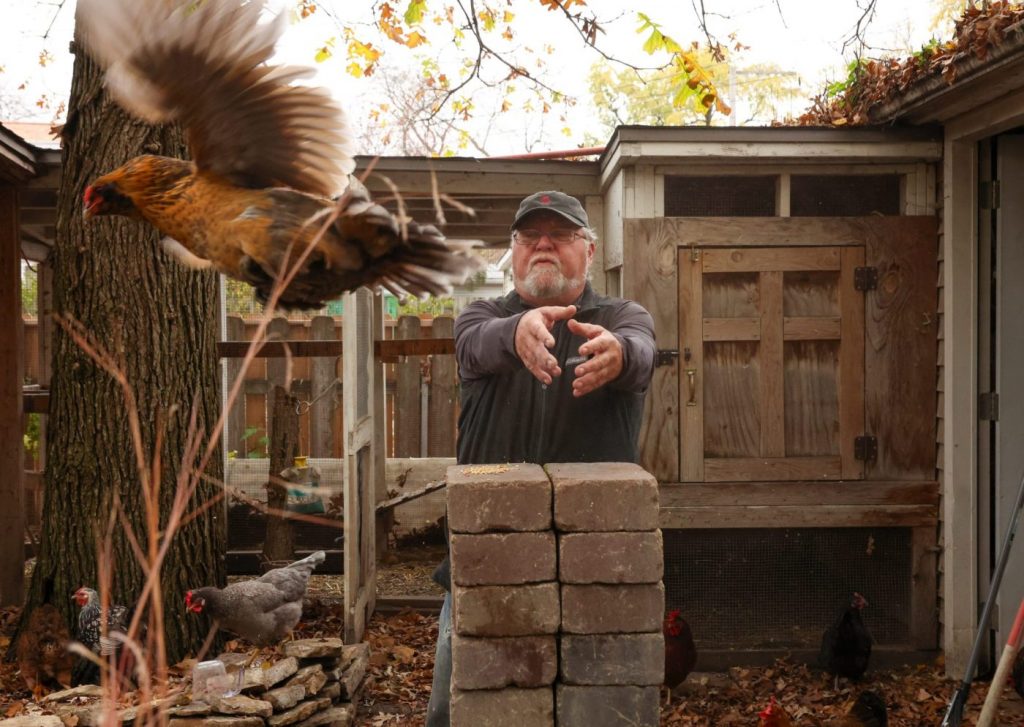Tim Norris’ 16 chickens enjoy free rein in his Irving Park, Illinois, backyard when he lets them out of their coop in the morning. A few perch on chairs or the fence on his porch, others meander through the Joe-Pye weed plants and a rooster named Buffy plops himself in a hole for a dust bath.
While the group tends to stick together, a young red hen named Annie avoids the rest, preferring to snack on the green plants beside Norris. He asks in a soothing voice if he can pick her up, before plucking some of the dirt and grime out of her feathers. She has a broken wing.
Annie is the newest — and probably most action-packed — addition to Norris’ flock. A woman found her wandering on a road in Chicago’s Lincoln Square last month, picked her up to save her from traffic and found her a new home with Norris. He’s one of likely hundreds across Chicago who keep pet chickens.
“They’re fascinating little animals,” said Norris, 68. “They’re like friendly dinosaurs, each one has its own personality. They’re just fun to watch.”
‘Complete pandemonium’
While Karen Olenski was driving down Western Avenue after work on Oct. 30, she spotted Annie standing in the road, looking confused as cars drove by her. Without thinking, Olenski said she pulled into the center lane and jumped into traffic with her right hand up to stop the oncoming cars.
Olenski, having no prior experience with chickens, struggled to grab Annie, who started to run away. Olenski said she was eventually able to scoop her up with her arms, and hold her close as she flapped around, while carrying her back to the car.
“I was like, well, what do I do now? I’ve got a dog in the car, and I couldn’t just put it in the back, because it would flop around,” she said. “So I scooted into the driver’s seat, I held it really close, tucked it close to me so I could at least stare out the car and drive back to my house.”
When Olenski got home, she said it was “complete pandemonium.” The chicken, who was shaking and scared, was squawking loudly in her arms. Olenski put Annie in a bathroom, while her daughter — who was “delighted and laughing” — took lots of pictures and posted them on Facebook to see if anyone was missing a chicken. She also played Yo-Yo Ma for Annie to hopefully calm her down.
Olenski scattered food, which a neighbor gifted her, on the floor, while Annie ducked and hid behind the toilet, she said. Her husband, David Cihla, then got ahold of Chicagoland “chicken consultant” Jennifer Murtoff, who put them in touch with Norris the next day.
Tim Norris carries an injured chicken named Annie in his backyard on Nov. 15, 2024, in Chicago. Annie was rescued a couple of weeks ago. (Stacey Wescott/Chicago Tribune)
The couple never found Annie’s prior owners. Their best guess is based on a Facebook comment, where someone said they saw a truck loaded with poultry nearby.
“I had heard a story about Karen when she was a little girl growing up, that she in her backyard would catch birds with her bare hands,” Cihla said about his wife. “So I think it was destiny that she found the chicken.”
Raising chickens in the city
Murtoff, who runs the organization Home to Roost, helps re-home around 15 to 20 chickens every year. Forest preserves or cemeteries are common dumping sites, she said. Most of her work, though, involves advising chicken owners in the city and suburbs on how to create safe homes for the animals, which she’s loved ever since she was a kid.
She said there are easily hundreds of people in the city who raise chickens — across many neighborhoods. They’re almost always considered pets rather than livestock, and people usually keep smaller flocks. She said the average is two to six chickens. (It’s legal to own chickens as pets in the city whereas laws in various suburbs differ.)
The first step to owning chickens is building the “biggest coop you possibly can,” Murtoff said. It also has to be predator-proof, and she recommends that they have adequate shelter for winter. Having a heating element isn’t as important as building a shelter that’s draft-free and dry, she said. She also cautioned that vet bills can be steep.
Tim Norris hand-feeds a chicken named Helen in his backyard on Nov. 15, 2024, in Chicago. Norris has been raising chickens and roosters for about 10 years. (Stacey Wescott/Chicago Tribune)
“One of the things that people don’t realize is that they are a 24/7 responsibility,” she said. “You have to be there to let them out of the coop in the morning. You have to be there to collect the eggs. You have to be there to put them in the coop at night. You also have to provide fresh food and water on a daily basis, if not twice a day.”
Annie’s broken wing
Norris’ fascination with chickens started about a decade ago when his roommate’s 11-year-old daughter asked to raise them and fulfill her dream of becoming a farmer. They bought six chickens from a pet supply store, and he’s added to the flock over the years. He now has three roosters and 13 hens and has expanded his coop twice.
He thinks of them as “pets with benefits.” Selling their eggs pays for their feed and upkeep, and he also enjoys hanging out with them. It’s almost like “chicken TV” watching them on his patio, Norris said.
“Nice evenings on the patio or even rainy evenings on the patio, when the chickens are out there before they go to bed, they all gather around me and cluck and preen and ask for food,” he said, adding that he gets lots of visitors at his fence for what seems to be a “weird neighborhood attraction.”
Annie, an injured chicken, walks around in Tim Norris’ backyard on Nov. 15, 2024, in Chicago. (Stacey Wescott/Chicago Tribune)
Annie — the name Norris picked because she seemed to respond to it — seemed like a perfect addition to his flock. She’s confident and easy to handle, Norris said. He supervises her walks around the backyard a couple of times a week to help the other chickens accept her.
However, she’s not completely out of the woods. Norris, who works in sound recording, discovered her broken wing when he took her home and examined her.
A vet said her chances for survival probably aren’t good unless the wing is amputated. He’ll evaluate his options at another vet visit. In the meantime, he’s hoping the exposed bone heals. He spent about $800 on the first appointment and said an amputation would likely cost thousands of dollars.
“I’m probably a little crazy,” Norris jokes. “But cash isn’t a huge problem right now, and it’s just a commitment. I picked her up and said I’d take care of her, so I’m just going to do it.”


